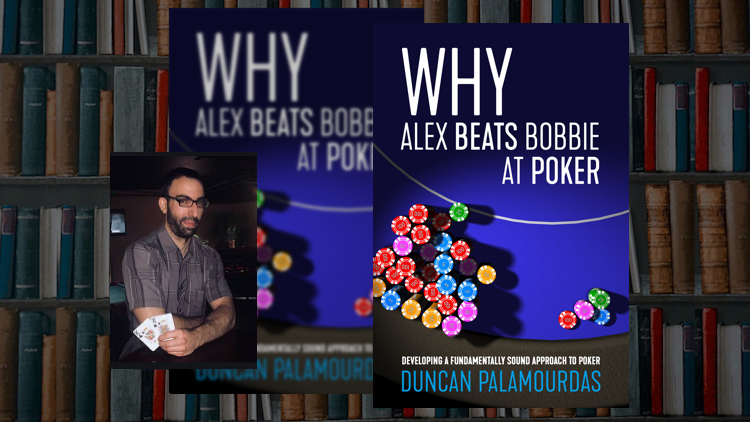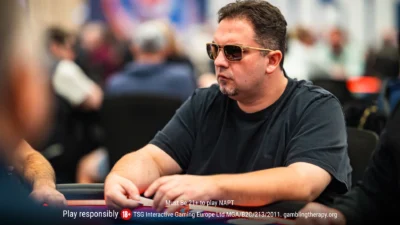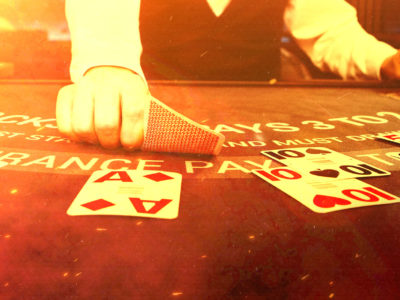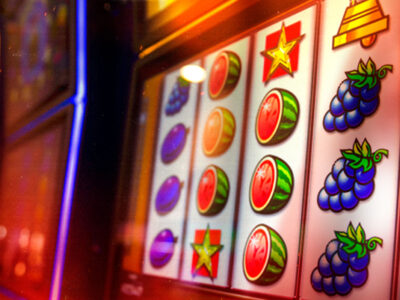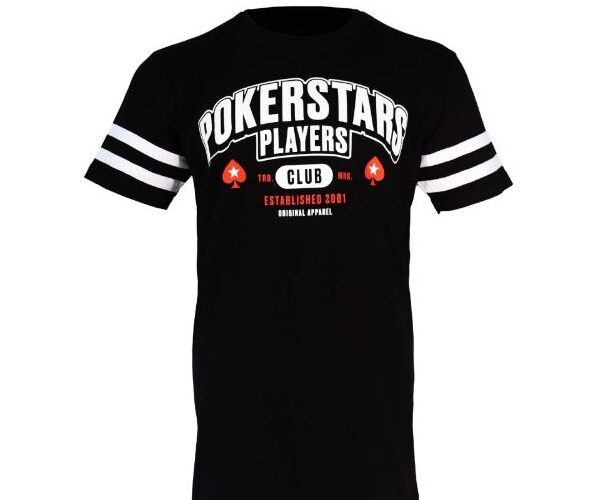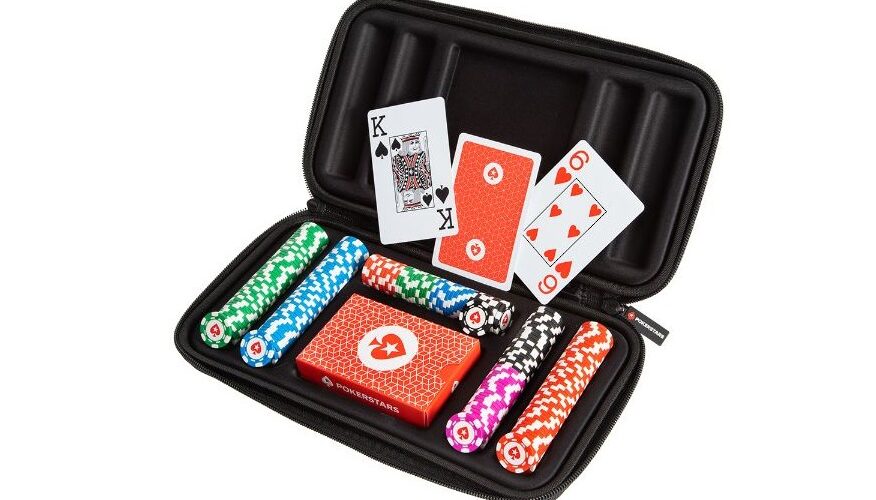Looking for a new strategy book to give as a holiday gift. D&B Poker has a suggestion.
Just out this month, Why Alex Beats Bobbie at Poker by UCLA math professor Duncan Palamourdas uses human psychology, game theory, easy-to-understand mathematics and even some philosophy to explain why some players consistently beat others.
As the title suggests, Palamourdas presents his ideas via a series of games and hands involving two poker players — Alex and Bobbie.
Alex is a poker pro. She plays for a living and has won consistently over the long term. Bobbie, on the other hand, is a recreational player. He is decent enough but mainly plays poker for fun.
It makes sense that Alex would beat Bobbie more often than vice-versa. But why? What does Alex know about poker that Bobbie doesn’t? That is what Palamourdas aims to explain in his book.
Palamourdas specializes in the mathematics of poker and poker education. He regularly teaches a poker course at UCLA for which enrollment is always full with long waiting lists.
His popularity as a poker teacher is partly a result of his love for simple language and metaphors. In Why Alex Beats Bobbie at Poker, Palamourdas consistently explains complex subjects in simple terms without resorting to technical jargon in order to help players solve frequently faced poker puzzles.
Topics covered include:
- Understanding the instinctive but unprofitable tendencies of inexperienced players
- How to identify what a mistake actually is in poker – and how to exploit it
- Why poker does not revolve around bluffing
- The great impact of variance in poker and how to account for it
- How to develop a consistent approach that allows you to play like Alex and not Bobbie
The following excerpt comes from the chapter titled “Money Saved is Money Earned.” Here Palamourdas takes us through a hand example in which Alex once again takes advantage of Bobbie.
The situation Palamourdas describes is a common one. After raising preflop, Alex has missed the flop and the board is very uncoordinated. Alex therefore wants to make a continuation bet (as a bluff), but doesn’t want to bet more than she needs to in order to get the job done.
How do we decide just the right amount to risk here? Read on and find out.
from “Money Saved is Money Earned”
Betting the absolute lowest amount you can get away with
One of the ways Alex likes to conceptualize poker bets is as “mistake generators.” The pressure that a properly sized bet can apply to her opponents often leads them to incorrect decisions, thus moving chips her way. Interestingly enough, the skill level of the player making the bet is typically immaterial. A bet is a bet and it is hard to deal with, whether you are an amateur or a pro….
Unless one has a nutty holding (which is rare), facing a bet always presents a difficult decision and is very annoying to deal with. The level of annoyance depends, of course, on who is making the bet, how they make it and who they target. It is still annoying nonetheless and that’s exactly why aggression is so important in poker.
Let’s further examine this by asking: what makes a bet “annoying” in the first place? Simply put — its size. The larger Alex’s bet, the more pressure it applies to her opponents. Of course, this is not the only factor she considers or she would go all-in every hand. Alex also wants to minimize her risk. This is because, every time she makes a bet, she knows that there is a non-zero chance that these precious chips may never come back to her. Thus, she has a built-in incentive to bet as little as possible. (Money not wagered is money not risked!)
This inevitably leads to a pressure/risk conundrum. She is supposed to bet as much as possible to maximize the pressure, while betting as little as possible to minimize the risk. Since Alex does not want her head to explode, she must find a way to resolve this issue. In all seriousness, this is one of the most fundamental questions a player must ask before placing a bet. As you can imagine, the size of a bet should depend heavily on the situation. Let’s start with a classic example to see how Alex would deal with the issue in practice.
Cash game: $5/10 with effective $1,000 stacks.
Alex open-raises to $30 from the CO with Q♠ J♠ . Bob calls from the BB, everyone else folds.
Flop: K♠ 8♦ 2♣ (pot: $65) Bob checks. What should Alex do?
First, let’s decide between betting and checking. To do that, we need to make a few observations based on what we know so far.
Fact #1: Bob likes to be involved in many pots, especially from the BB, where he is getting a huge discount on his hands. This means that his range of hands should be wide here.
Fact #2: The board is as disconnected as it gets. This means that there are literally no draws that Bob could be working on. In addition, since the card denominations are “far” from one another, it is very unlikely that Bob has two pair. Even loose players do not like to play hands which are too far apart (like 8-2 for example). Lastly, since Bob would probably re-raise with K-K before the flop, he cannot have that either. So unless Bob has exactly 8-8, 2-2, K-8 or maybe K-2s, this board is all about having a pair or not. We have already established how hard it is to make a pair in this game! Therefore, it is safe to say that Bob likely did not connect on that board.
Fact #3: Alex did not connect either. However, her hand still has a few ways to improve. She could catch a Q or a J on the turn or river. This may not seem like much, especially with the K on the flop, but either would still be useful in case Bob has a lower pair than a K, say with a hand like 9-9 or 8-7. Another way to improve would be by runner-runner spades, or runner-runner straight cards (like a 10 and a 9). Neither is particularly likely, but they provide extra chances against the already rare pairs that Bob may have.
We can summarize all of the above as follows: It is pretty unlikely that Bob connected on that board, but even in the off chance he did, Alex still has a chance to improve and beat Bob by the river. With that in mind, it is pretty clear that Alex should bet the flop, instead of checking it back.
Ok, great, but how much should Alex bet? Probably the best way to answer is to step into Bob’s shoes and evaluate some different-sized bets from Alex. If Bob is like most recreational players, he probably has some rough labeling in his head to categorize Alex’s bets, perhaps something like: “Small bet,” “Normal bet” and “Big bet.” So if Alex bets $250 into a pot of only $65, Bob is likely to think: “Big bet!” while if she makes a bet of $10 he may think “Small bet!” Similarly, if she bets $50, he may think “Normal bet!” It is worth emphasizing that words like “Small,” “Big” and “Normal” are meant to act as subjective strategy triggers for Bob, at least in a rough/average sense. For instance, Bob may have a tendency never to fold against (what he interprets as) Small bets, even when he has nothing. At the same time he may like to generally fold all of his no-pair/no-draw hands against Normal bets, while he may be likely to fold everything but nutty holdings against Big bets.
The key idea, however, is that Alex has many more bet-sizes than Bob has categories. This means that, in an effort to keep things simple, Bob is forced to use the same label for bets of different sizes, multiple times over! For example, if Alex bets $200 (instead of $250) Bob may still think “Big bet!” If she bets $25 (instead of $10) he may still think “Small bet!” Similarly, if she bets $30 (instead of $50) he may think “Normal bet!”
This may look like a simple observation but it has huge repercussions. It means that Alex could manipulate her bet-sizing and still be within the desired perceived category. In our example, Alex probably wants to make a “normal”-looking bet so she can get all the desirable folds she wants. As we have assumed that Bob would perceive both $50 and $30 as “Normal” bets, why bet $50 when a $30 will work (saving her $20 in the process!)? Why risk more when she can get the same result with less? This is the concept of betting as small as we can get away with! It is betting the least amount necessary to achieve a certain goal. Once again, $20 in savings may not seem much, but hopefully it is pretty clear by now why — in the long haul — this strategy could save Alex a ton of chips, which, as we saw, can be used to increase her leverage against her opponents in the future.
Duncan Palamourdas’ Why Alex Beats Bobbie at Poker is now available in paperback or as an e-book from D&B Poker.
D&B Publishing (using the imprint D&B Poker) was created by Dan Addelman and Byron Jacobs 15 years ago. Since then it has become one of the leading publishers of poker books with titles by Phil Hellmuth, Jonathan Little, Mike Sexton, Chris Moorman, Dr. Patricia Cardner, Lance Bradley, Martin Harris and more, all of which are available at D&B Poker.
Back to TopView Other Blogs




